STATEMENT OF
POSTMASTER GENERAL/CEO PATRICK R. DONAHOE
BEFORE THE
COMMITTEE ON HOMELAND SECURITY AND GOVERNMENTAL AFFAIRS
UNITED STATES SENATE
FEBRUARY 13, 2013
Good morning, Mr. Chairman, and members of the Committee. Thank you, Chairman Carper, for your continued leadership on comprehensive postal legislation and for calling this hearing to discuss solutions to the precarious financial situation of the nation’s Postal Service. During the 112th Congress, the Senate took decisive action to pass bipartisan postal reform legislation in the form of S. 1789, the 21st Century Postal Service Act. While that effort was appreciated, it ultimately did not lead to enacted legislation. We strenuously urge the 113th Congress to act swiftly, completing the work that was begun in the previous Congress. Time is of the essence, and each day that passes without enacted postal reform further impacts the Postal Service’s already dire financial condition. The Postal Service is losing $25 million per day. We must close a projected $20 billion gap between revenues and expenses. A wide array of strategies, detailed in this testimony, is needed to accomplish that. No single action will solve the Postal Service’s precarious financial situation. If legislation is not enacted – and soon – to provide the necessary reforms and flexibilities to achieve savings and generate new revenues, we will all be back here again, discussing the same issues. Changes of this magnitude require courage. I am glad to be here to discuss these important issues, which have grown more urgent over time.
The Postal Service continues to face tremendous financial challenges, last year alone recording a loss of $15.9 billion. The Postal Service has seen net losses for five consecutive quarters, and for 14 of the last 16 quarters. We defaulted on Retiree Health Benefits (RHB) payments to the United States Treasury totaling $11.1 billion. While a large part of the loss can be attributed to the statutorily mandated RHB prefunding requirement, the Postal Service has experienced billions in operating losses for each of the past four years as well.
Contrary to some opinions, resolving the RHB prefunding requirement alone will not fully address the problem. The table below shows the impact of all combined activity, including legislative action, on our net operating income between now and Fiscal Year 2017. [Figure 1]
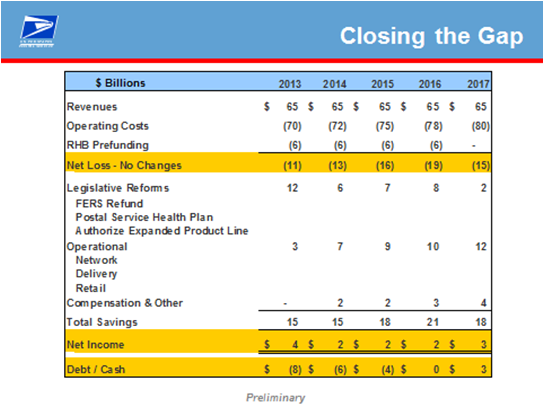
Figure 1
The Postal Service has exhausted its borrowing authority of $15 billion, and it continues to contend with a serious liquidity crisis. At one point in October 2012, the Postal Service had less than four days’ worth of cash on hand to fund operations. For an organization the size of the Postal Service – which has revenues of $65 billion and a career workforce of 495,000 – that is an unacceptable margin. This is not a position in which a healthy company finds itself. By way of comparison, most private sector companies usually have two months of cash on hand to fund operations.
Even with volume declines, in Fiscal Year 2012, the Postal Service delivered approximately 160 billion pieces of mail, approximately 40 percent of the world’s mail volume. However, total mail volume, particularly First-Class single-piece (stamped) mail, has declined by a staggering 20 billion pieces, or 40 percent, over the past five years. As a result, the Postal Service must adjust its operations accordingly. The use of First-Class Mail, the Postal Service’s most profitable product, continues to decline year after year. People want to receive hard copy statements and other business correspondence through the mail, but they are electing to pay bills online. This is a trend that will continue to erode postal revenues and is a primary cause of the Postal Service’s financial challenges.
It is clear that the Postal Service cannot continue along our current path. Our existing business model is unsustainable, and projections show continued and increased losses into the future – unless a comprehensive set of changes is made. No single solution will solve these financial issues. Success can only be achieved when all stakeholders, including Congress, work together to put in place comprehensive and meaningful reform. The Postal Service continues to effectively manage all aspects of our operation over which we have control. In fact, we have had 17 consecutive quarters of productivity improvements, despite volume losses. We are making hard decisions now to preserve our mission to provide secure, reliable, and affordable universal delivery service.
The future of the Postal Service can be bright, if Congress allows the necessary flexibility and legislative reform. We can return to financial stability and we can do so with no impacts or burdens on American taxpayers. One key to success is gaining enhanced flexibility to adapt to a rapidly changing marketplace. This flexibility will enable us to remain profitable, by giving us the tools to operate more efficiently, create new products and innovations and to control costs. Absent this flexibility, the Postal Service will continue to experience sustained losses, in spite of our long-term efforts to reduce costs.
The Postal Service continues to aggressively pursue strategies within its control to increase efficiency and to improve its liquidity position. These measures include consolidating the mail processing, retail, and delivery networks in order to better align them with mail volumes, pursuing new revenue streams, and reducing workforce costs. Despite the constraints within our current business model, the Postal Service has, for over a decade, been very aggressive in its efforts to match our operational model to continually shifting customer demands and habits. Since 2006, we have reduced the size of our workforce by 193,000 employees and have reduced our cost base by $15 billion. Our goal is to reduce our career workforce to 400,000 employees through attrition. Using thoughtful and careful planning, we have consolidated more than 200 mail-processing facilities. Under the Post Office Structure (POSt) Plan, the Postal Service is modifying operating hours at over 13,000 Post Offices, while preserving postal services, especially in small and rural communities. Through careful evaluation, we have reduced some 21,000 delivery routes, resulting in a leaner and more efficient delivery network. We have continued to provide increased access to postal products and services, so that customers can now do business with us in over 100,000 locations, plus the Internet.
While we continue to seek out all possible efficiencies and savings, we also put tremendous effort into retaining existing revenue streams and seeking out new sources of revenue. One of the most exciting growth sectors for the Postal Service has been in our package business, which has seen 14 percent growth over the last two years. In addition, Direct Mail continues to be the single best return on investment by offering the highest response rate for advertisers. This has been fueled by effective product innovation and marketing, and the continued rise in e-commerce. We expect this business to continue to grow. In 2012, the Postal Service announced the creation of its Digital Solutions Group (DSG), to find innovative ways to use technology in order to better meet customer needs.
Still, as noted earlier, the continued year-over-year sharp decline in First-Class mail single-piece, traditionally our most profitable product, will further erode Postal Service revenues. The chart below illustrates shifting revenue trends over the last several years. [Figure 2]
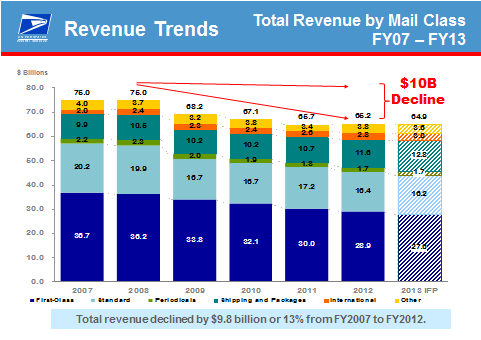
Figure 2
With the shifts in customer mailing habits, the $10 billion decline, shown above, is driven primarily by precipitous drops in First-Class Mail volume. Current law limits the Postal Service in its ability to offer new products and services. The primary challenge for the Postal Service is striking the right balance between cost cutting and revenue generation. Even with our intense focus on these areas, a lack of flexibility in our business model continues to hinder efforts to close a widening budget gap. The Postal Service must generate roughly $20 billion in cost reductions and revenue generation by 2016 to return to financial stability. But our efforts will only go so far. Legislative change is needed now.
The chart below illustrates that, even with continued efforts by the Postal Service to trim costs, without legislative change, the budget gap remains wide. [Figure 3]
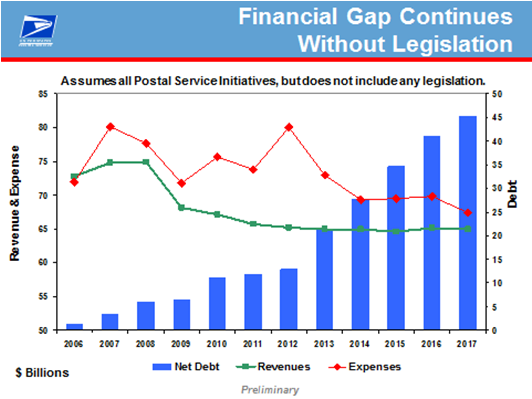
Figure 3
In the absence of enacted legislation, we are taking every reasonable and responsible step to immediately strengthen our financial outlook. On January 14, 2013, the Postal Service’s Board of Governors directed postal management to accelerate the restructure of Postal Service operations to further reduce costs and generate revenue in order to bolster its finances. The Board is taking all steps under its control to operate the Postal Service like a business.
Last week, the Postal Service announced a new six-day package delivery and five-day mail delivery schedule, effective the week of August 5, 2013. The anticipated savings from this schedule, when fully implemented, is approximately $2 billion annually. This step will close approximately 10 percent of the $20 billion budget gap. The new delivery schedule will provide mail delivery to street addresses Monday through Friday. Mail addressed to P.O. Boxes will continue to be delivered on Saturdays. Post Offices open now on Saturdays will not be affected by this decision. Packages will continue to be delivered six days per week and Express Mail, currently delivered seven days per week, will not be impacted. This plan serves a dual purpose; to respond effectively to the increase in package growth – a 14 percent volume increase over the last two years – and to address the realities of the public’s changing mailing habits. In March, we will publish specific guidance for residential and business customers, regarding this new delivery schedule.
Although our decision was guided primarily by operational and cost savings needs, market research performed over the last few years has shown consistently high levels of support from the public – nearly seven in ten customers approve of a switch to five-day mail delivery as a way for the Postal Service to reduce costs. We expect even greater support for our new schedule, which maintains six days of package delivery. We urge Congress to take no action that would prohibit the change to five-day mail delivery.
Our new delivery schedule is merely one part of a larger strategy to close the existing budgetary gap. Although we will realize approximately $2 billion annually in savings, when five-day mail delivery is fully implemented, that leaves another $18 billion that must be addressed and eliminated. No single solution will return the Postal Service to financial stability. A combination of actions must take place, and the timing of these changes is critical. The longer we wait to make structural changes, the greater the liabilities and losses grow. The shortfall of $20 billion will only grow larger with inflation and the opportunity cost of taking no action.
A significant part of this needed structural change is reforming the laws that govern the Postal Service. The Postal Service, through its ongoing implementation of operational strategies and initiatives, and through new and innovative products and services, is able to close the $20 billion budget gap to some degree; however, the remaining gap can only be closed through enactment of legislation.
Key Legislative Goals:
During the 112th Congress, the Senate passed S. 1789, which included many reforms sought by the Postal Service. Below are reforms we think are important. They include:
- Require USPS Health Care Plan (Resolves RHB Prepayment Issue)
- Refund FERS Overpayment
- Streamline Governance Model
- Authority to Expand Products and Services
- Require Defined Contribution Retirement System for Future Postal Employees
- Instructions to Arbitrator
- Reform Workers’ Compensation
- Right to Appeal EEOC Class Action Decisions to Federal Court
Require USPS Health Care Plan:
In February 2012, the Postal Service introduced its Five-Year Business Plan, which contained a set of strategies and initiatives designed to close the substantial and crippling budget gap. We are currently in the process of updating the plan and will be happy to brief you and your staffs once the update is complete. One of the most important proposals contained in our plan and one which represents tremendous cost savings is a change in the way we provide health care to our employees and retirees.
An astonishing 20 cents of every revenue dollar the Postal Service takes in must go toward health care costs. [Figure 4] The cost of this large component of our total operating costs, second only to wages, is largely outside of our control.
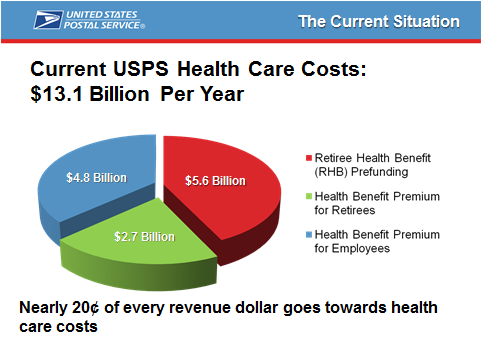
Figure 4
There is a substantial opportunity for savings – up to $7 billion each year through 2016 – by moving to a more modern, responsive and customer-focused system. This would involve having the Postal Service sponsor its own healthcare plan. By moving away from the federal system, nearly all of our employees and retirees would reap the benefits of getting equivalent or better healthcare coverage and paying less for it.
A Postal Service sponsored health care plan is critical, because it resolves the root cause of soaring healthcare costs – the issue of liability. Without addressing the liability issue in a responsible way, the Postal Service will be unable to sustain the current approach to providing health benefits to retirees. In its proposal, the Postal Service would sponsor its own health care plan independent of the Federal Employee Health Benefits (FEHB) program. This would include employees, as well as current and future retirees. Congressional action to allow this fundamental change would dramatically reduce health care spending, helping the Postal Service take a significant step toward financial stability. It would also provide savings for employees and retirees. Our health care plan proposal provides savings and benefits in a variety of ways:
- Helps return the Postal Service to financial stability. Preliminary estimates indicate savings would exceed $1 billion in reduced premiums for the Postal Service in the first year, and $600 million in reduced premiums for employees.
- Eliminates the need for future scheduled RHB prepayments (ranging from $5.6 billion to $5.8 billion annually) under the PAEA by reducing the unfunded liability to a manageable level.
- Leverages the tremendous buying power of more than one million employees and retirees to obtain better pricing.
- Achieves significant savings for the Postal Service, employees and retirees.
- Maintains the Postal Service’s commitment to provide quality health care coverage to our dedicated workforce and retirees, as the cost of FEHB plans is unstainable.
- Implements best practices such as improved prescription coverage, integrated care and disease management, wellness incentives, and integrated Medicare and Employer Group Waiver Plans (EGWP) for retiree health benefits.
- Enables better choices with simple, more understandable options.
Regarding the RHB unfunded liability issue, below is a chart [Figure 5] showing how each plan component listed above reduces this liability from $53 billion down to just $1.4 billion, with a Postal Service-sponsored health care plan. Attached to my written testimony, and submitted for the record, is a white paper with more detailed descriptions of our health care plan proposal.
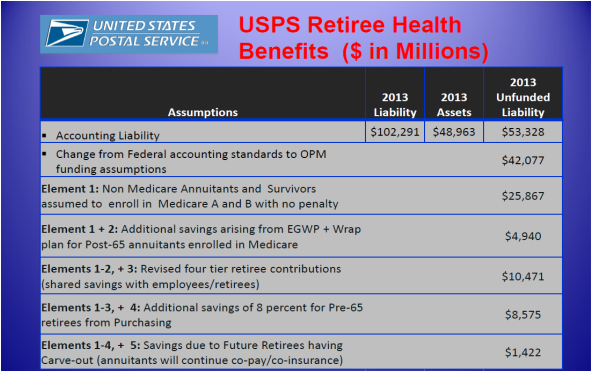
Figure 5* [*Preliminary figures]
Refund FERS Overpayment:
Postal Service employees participate in one of three Federal government pension programs. These programs are administered by the Office of Personnel Management (OPM), and employees and the Postal Service contribute to the programs. The funding calculations provided by OPM, with respect to the Federal Employees’ Retirement System (FERS) have determined that the Postal Service has overfunded FERS and that a surplus exists. According to the most recent actuarial estimate from OPM, the Postal Service has overfunded its FERS obligation by $2.6 billion, as of September 30, 2011. This estimated surplus is less than amounts previously reported, due to changes in the government-wide economic and demographic assumptions made by OPM. OPM’s most recent calculation shows that the surplus is projected to have grown to approximately $3.0 billion by September 30, 2012.
In December 2012, the Postal Service’s Office of the Inspector General (OIG) issued an update to a previously released paper on the causes of the FERS surplus. The Postal Service agrees with the two major conclusions in the OIG’s report. First, the distinctive characteristics of the Postal Service workforce, including lower salary increases than the rest of the Federal government, suggests that our FERS surplus is larger than the OPM’s current calculation, and OPM should use Postal Service specific data to calculate the surplus. Second, in order to prevent excessive surpluses from accumulating in the future, OPM should adjust the USPS’ FERS contribution rate. The current FERS charges are too high, as evidenced by 20 years of surpluses, and contribute to the Postal Service’s financial crisis. Third, once calculated, the current deficit should be refunded to the Postal Service. The Postal Service, using postal-specific demographics and assumptions, calculates the FERS overfunding amount to be approximately $6 billion. Directing OPM to utilize postal-specific demographics and assumptions in calculating the correct amount of the FERS surplus and returning the full amount of that surplus to the Postal Service is important, and should be completed this year.
Streamline Governance Model:
The Board of Governors has the responsibility to manage the Postal Service, but does not have adequate authority to do so. In order to meet the challenges it faces both today and in the future, the Postal Service must be given the tools to become a more nimble, streamlined organization, better able to respond quickly to the needs of a dynamic marketplace and to adjust our operations as demand for products and services evolves. Current law has not created a foundation by which the Postal Service can provide universal service in a financially sustainable manner.
In terms of network costs, the Postal Service Board of Governors should have the clear authority to make structural changes that reduce the costs of the retail, processing and delivery networks. Currently, the Board considers the submission of each major operational decision to the Postal Regulatory Commission (PRC) for an advisory opinion following a litigious, lengthy administrative proceeding that does not promote timely and effective implementation of necessary, efficient cost reduction decisions. The current process imposes substantial costs on the Postal Service and delays savings and should be eliminated. At a minimum, PRC procedures should be substantially streamlined and should be after-the-fact reviews or handled through the complaint process.
Another facet of restoring financial sustainability is the growth of revenue through product and pricing innovation, both with respect to existing lines of business and other lines of business. Giving the Board greater authority to exercise business judgment in this area does not mean the end of oversight by an external entity. A more nimble and well-defined regulatory approach is required that minimizes unnecessary bureaucracy, recognizes the Postal Service faces intense competition with respect to all of its products, and allows the Board to respond effectively to changing conditions. Even the PRC recognized in its Annual Report that the current system of regulation is not achieving the objective of financial stability.
Giving the Postal Service greater flexibility over pricing and product innovation would further advance the goal of providing universal service in a financially sustainable way. This is demonstrated by experience in other countries in which postal operators have been given such flexibility. The Postal Service, like other postal operators, is in the best position to determine the strategies necessary to ensure financial stability. In addition, the Postal Service faces the same competitive pressures as other postal operators, and has strong commercial incentives to be efficient and responsive to its customers’ needs in order to ensure its products are competitive. Extensive price and product controls are therefore not necessary. Pairing much greater flexibility over pricing and product innovation with additional flexibility to address network costs would put the Board in a position to create a multi-faceted and balanced approach to restoring financial stability.
Authority to Expand Products and Services:
The Postal Service must be allowed authority to establish new revenue sources and respond to a changing marketplace. The provisions contained in S. 1789 from the 112th Congress were helpful in providing flexibility to the Postal Service to offer products and services that would improve our net financial position. The Postal Service’s financial viability is dependent not only on cutting costs but also generating additional revenue. As such, legislation enabling the Postal Service to offer additional products and services is a key component of our ability to continue to generate new revenue and improve our financial condition.
Require Defined Contribution Retirement System for Future Postal Employees:
The Postal Service’s current employees participate in one of three federal government pension programs, all of which are defined benefit plans. But the Postal Service is changing. Employees coming in now have a much different future than current employees. We should provide a retirement system that benefits both the employee and the Postal Service.
Young people in the workforce today do not stay with a company for 25 or 30 years like so many of our current postal workers. They tend to move around much more frequently, and a defined contribution system that is portable, sustainable and consistent with the private sector will serve their needs best. The employee would get their benefits up front and would not have to wait for them. In turn, the Postal Service gets cost predictability, which is sorely needed, especially in the area of compensation and benefits. Nothing would change for existing employees, and the Postal Service would fulfill its obligations to all employees currently enrolled in the existing plans. Future employees would be fully informed when they enter the postal workforce, as to how their defined contribution plan would benefit them and their families.
Instructions to Arbitrator:
More than 85 percent of the Postal Service’s career employees are covered by collective bargaining agreements. The Postal Service has included in its legislative goals the request that Congress enact provisions that instruct interest arbitration panels to consider the financial condition of the Postal Service in interest arbitration awards. Although some argue that interest arbitrators do this already, they cannot function like bankruptcy courts under Chapter 11 in the private sector. The panels cannot restructure the Postal Service regulatory or business model. They do not have the authority to look at the entirety of the Postal Service’s finances—indebtedness, pricing, operations, service standards, capital sources, debt relief, etc.
All the panels can do is address wages and benefits for a particular bargaining unit and even there the panel’s power is limited, because they cannot alter or modify statutory benefits like retiree health care or defined benefit pension plans. Given these inherent limitations (which were explicitly recognized by the panels in the two most recent awards involving the NRLCA and the NALC), we believe it is especially important for Congress to make certain that the arbitration panels take into consideration the Postal Service financial condition in the areas they do have authority to address: wage rates, leave, health care contributions, workforce mix, job protections and related matters and to make that legislatively explicit. The Postal Service needs legislative language requiring arbitrators to consider the Postal Service’s overall financial health.
Reform Workers’ Compensation:
Postal employees injured on the job are covered by the Federal Employees’ Compensation Act (FECA), administered by the Department of Labor’s (DOL) Office of Workers’ Compensation Programs (OWCP), which makes all decisions regarding injured workers’ eligibility for benefits.
The Postal Service has made tremendous strides in reducing its accident and injury rate, as measured by the Occupational Safety and Health Administration (OSHA). Since 2003, the rate of reported injuries has dropped by over 50 percent. By developing and implementing innovative and effective safety programs, we continue to drive down accidents and injuries and provide our employees with a safe work environment.
Even with this success rate, substantial workers’ compensation costs exist. We currently have 16,999 employees on the periodic roll, being paid for total wage loss. On a yearly basis, the Postal Service must make payments to the DOL to reimburse them for all workers’ compensation benefits paid to or on behalf of employees, in addition to paying an administrative fee to the DOL. Current workers’ compensations costs are $1.4 billion per year. We have accrual claims costs of approximately $17 billion, making workers’ compensation the Postal Service’s largest liability.
S. 1789 contained provisions that would have made reforms to the existing workers’ compensation program, including modifications to current rates of compensation for varying classes of injured employees. It would also have required retirement eligible employees to transition from workers’ compensation rolls and onto the appropriate retirement program, upon reaching retirement age. Any future legislation must contain similar language.
Right to Appeal EEOC Class Action Decisions to Federal Court:
Similar to the significant strides made in reducing accidents, the Postal Service has reduced EEO formal complaints by 40 percent since FY 2004, ensuring compliance with the law. Today, however, the Postal Service is subject to class actions in the Equal Employment Opportunity (EEO) process that we believe have been improperly certified. Defending against these class actions is extremely costly and burdensome, regardless of their merit. We believe we should have the right to appeal to the federal court final decisions of the EEOC. This is similar to the Postal Service’s existing authority to appeal decisions of the Postal Regulatory Commission (PRC).
Conclusion:
Mr. Chairman, time is of the essence. Every day that delays enactment of meaningful and effective postal reform legislation, the $20 billion gap grows. We are losing $25 million a day. Every option has to be put on the table. These legislative goals cover a wide array of concerns and issues. No one single solution is enough, however. We agree that piecemeal efforts simply will not work.
We must make the hard decisions and act now to implement solutions. The financial problems of the Postal Service grow larger every year. Delaying reform for another year or more will only accelerate our already dire financial condition. Our liquidity will continue to be threatened and the day may come when we have insufficient cash to pay our employees or suppliers. Talk of an insolvent Postal Service has already made some customers look for other alternatives.
Mr. Chairman, in order to preserve our mission to provide secure, reliable, and affordable universal delivery service to all U.S. residents – and do so without burdening the American taxpayer – the Postal Service needs urgent reform to its business model.
The American people deserve a financially healthy and vital Postal Service. We must take courageous, aggressive and, yes, sometimes controversial steps now to ensure a reliable Postal Service for our customers and a bright future for our employees. The Postal Service is committed to working with you, and the rest of the Committee to achieve that goal. Thank you.
